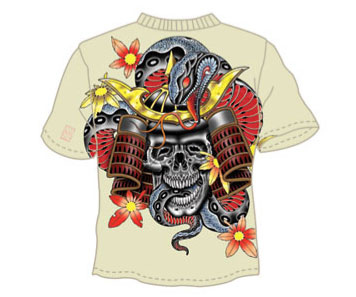 This will be an unusual post in more than one way.
This will be an unusual post in more than one way.
First, it’s about a decidedly low-tech retail business, that does not really fit this blog’s profile.
Second, it’s about a business I don’t personally care for: designer t-shirts. Tees are in the conference schwag category for me, I barely ever spend on them, and $110 (even $55 after discount) is an outrageous price, if you ask me.
Third, I really don’t like tattoo’s – and this line is all about reprinting tattoos. Yuck. (But that’s just me.)
Fourth, I am reprinting an email sent to me in it’s entirety. Rest assured, I’m doing it with the sender’s permission. I’m lazy, don’t wan to write a post and this makes a perfect story. Ok, joke apart, keep on reading, there is something about creative business models here. Here’s the letter (emphasis mine):
Hello! My name is Jeremy Parker and I am a 23 year old entrepreneur. I am the CEO of Tees and Tats, a high-end, limited edition t-shirt line designed by world renown tattoo artist Marco Serio. We launched the line last July, with much success, selling to many high-end boutiques all over the US and Canada.
But starting last November, are sales starting to slow dramatically as with the rest of the economy. A large percentage of the stores we were selling to closed, and the stores that have survived are not placing re-orders. I did not want to concede to failure- because if the entrepreneurial spirit dies, America will be in a much worse place. I knew the store issue would still be a problem, because high-end retailers are not buying goods anymore, but I came up with an idea that I thought might help our online sales.
I first lowered our prices from $110 to $55. This helped a little bit, but people where still not buying like we saw earlier. So I came up with a concept that at the time seemed bizarre, but now has proven to be a savior for us.
Now when a customer buys a shirt on our website (www.teesandtats.com), they are told the price of the DOW. For every 100 points that the DOW drops within two months after the time of purchase they receive $5 dollars off of their purchase. For example if a customer buys a shirt for $55 dollars and the DOW is 8200 and two months later the DOW is 8000 – the customer gets a check in the mail for $10 dollars. The reason why people aren’t buying high-end fashion- is that they are nervous about affording food, rent and other necessary living expenses. Obviously very understandable. So by assuring them that if the economy deteriorates even more they would get some money back – it made it very enticing for many customers. Our sales have been up significantly since we started this.
One important additional element to the Tees and Tats philosophy is our desire to give back. For every T-shirt sold in the initial collection, we are going donate a percentage of proceeds to the non-profit ArtWorks Foundation. Based in Englewood, N.J., ArtWorks provides children and young adults suffering from chronic and life-threatening illnesses, and their siblings, access to creative and performing arts programming which encourages the use of the creative process as a vehicle for healing, communication, self-expression, and personal development. (I actually chose this charity to give to because of your piece on them a few years back.)
I just want to thank you for listening to my story, and I want to say that as things are looking bad and seems to be getting even worse – It is going to be the American people who are going to fix this problem.
Best Wishes,
Jeremy Parker
Wow. Talk about creative business models. The discount is quite deep, 100 points on the DOW is nothing percentage-wise, yet it earns a 10% discount on your tee-price. The company maximized the “DOW-insurance” program at 700 points, which would equate $35. Is this a funny way of declaring the true bottom price of $20?
The discount is quite deep, 100 points on the DOW is nothing percentage-wise, yet it earns a 10% discount on your tee-price. The company maximized the “DOW-insurance” program at 700 points, which would equate $35. Is this a funny way of declaring the true bottom price of $20?
There are a lot of open questions I have not verified around whether customers actually received refund checks, how market rallies may interfere with the calculation ( is there a specific “date of record” or duration the DOW has to stay low), etc.
Still, I wanted to share this story as an example of thinking outside the box: a virtue a lot of startups (and established businesses) need nowadays to survive in the face of recession. I don’t know if Jeremy will be running Tees and Tats a few years for now – but I am quite sure he’ll be running something. He’s an Entrepreneur.


Recent Comments